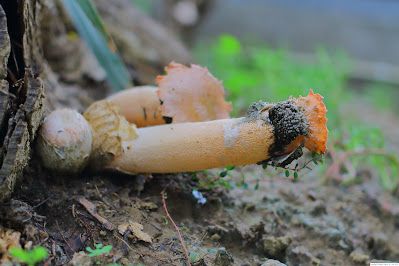Most National parks shut down by the time the monsoons arrive and wildlife photographers have to take a break. However, a wonderful and amazing world opens up to the lens, colourful, exciting and simply waiting to be discovered. Unfortunately very few of us bother to look down at the ground to see an amazing world waiting to be discovered!
Some mushrooms are difficult to identify and name. Quit a few of them might be psychedelic in in nature while others might be highly poisonous in nature. I spotted this weird looking mushroom and though I tried identifying it, google lens et al, I failed to do so!
Guttation in mushrooms refers to a phenomenon where liquid droplets are exuded from the fruiting body of the mushroom. This is how mushrooms force out excess moisture. In the case of Ganoderma linghzi mushrooms, the liquid might contain secondary metabolites, proteins and bioactive substances. Interestingly mushrooms have a metabolic process similar to plants. Check out the photograph below, which is that of a Ganoderma lingzhi mushroom undergoing a process of guttation.
 |
| Ganoderma lingzhi Mushroom undergoing guttation |
 |
| A Millipede approaches a Ganoderma mushroom. |
Macro photography has its own specifics and requirements. You need to abandon your telescopic lens and instead choose a macro lens. I decided to experiment with a Canon-40mm F-2.8 pancake prime lens a lens that people more often use for street photography and portraits with amazing results. I abandoned my tripod and instead used a Manfrotto mini tripod in a folded state as a selfie stick or rather as a grip to point the camera through tight corners and angles.
 |
| A Millipede backs up on itself. |
Millipedes and Phallic Stinkhorns have a very important function. They might be labelled as nature's recyclers. Millipedes feed on fallen leaves converting them into manure while Phallic Stinkhorns grow on fallen logs and tree stumps feeding on them and reducing them into assimilable material. Ganoderma mushrooms feed on living trees and often have a parasitic nature. Ganoderma Linzhi mushrooms have various health benefits and extracts made from them are sold as cures for cancers, and respiratory illnesses.
It is indeed an amazing world waiting to be discovered. A study of the micro world teaches us about how micro organisms work hard to recycle organic waste like leaves and other objects. Mushrooms are fascinating and a joy to photograph. Amazingly, Stinkhorn Mushrooms have a distinctive stink while Ganoderma Linghzi Mushrooms have distinctly bright colours contrasting with an ice-cream white top surface.







No comments:
Post a Comment